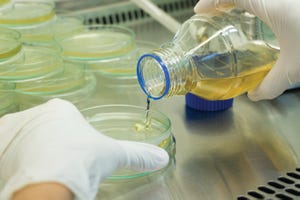September 2023
Sponsored Content
With another September comes another collective sprint to the end of the year. Because of our three-month minimum span from receipt of a manuscript to its publication, we already are planning our January–February issue. But between now and then, we have plenty to do. The publication’s editors, Dan Stanton’s
BioProcess Insider
team, and our conference colleagues are gathering up ideas, comparing notes, evaluating trends, and creating editorial and conference calendars for 2024. The BPI conference and colocated meetings are coming up at the annual Biotech Week Boston (18–21 September) as you receive this issue.
With our calendar still open for suggestions and early planning for the 2024 events underway, this is your opportunity to share topics with us that you want to see BPI tackle next year. A draft of our the editorial calendar will be ready for BWB, but we will continue refining that afterward, so we welcome your ideas.
This year has been difficult to navigate for almost everyone. Operating budgets, s...
HTTPS://WWW.ALAMY.COM
Chief executive officers (CEOs) and board chairs from Roche, GSK, and AstraZeneca are among seven signatories on an open letter calling for bioprocess suppliers to commit to specified climate and sustainability targets. Stating that the healthcare sector contributes about 5% of global greenhouse gas emissions, half of which comes from its supply chain, the authors call on their biopharmaceutical-ecosystem partners to move rapidly together toward a “greener, more efficient, and circular” process.
The letter is signed by representatives of big pharma companies as well as contract biomanufacturer Samsung Biologics. It urges suppliers to sign on to a set of joint, minimum climate and sustainability targets. Those are based on core commitments laid out by the same seven companies ahead of the 2022 United Nations Climate Change Conference in November of last year (
1
).
In short, those targets are
• to assess and disclose emissions by 2025
• to set near-term targets aligned with the 1.5-°C...
HTTPS://WWW.ISTOCKPHOTO.COM
Big data, next-generation sequencing (NGS), automation, and powerful analytical technologies are helping biopharmaceutical companies achieve the parallel goals of cell-line development: precise integration of transgenes into production cells with documented monoclonality, shortening timelines and increasing productivity. Presentations in the most recent Biotech Week Boston (BWB) and the BPI Conference US West (BPI West) programs have demonstrated that there is no one way to accomplish those goals. Combining several of the approaches highlighted herein just might take biopharmaceutical production to new levels that not long ago would have been deemed impossible.
In BPI’s April 2023 featured report, we reported on discussions in Boston, MA, this past fall (
1
). The BPI Conference program within BWB included both a preconference workshop on CLD and topical talks within the upstream production track. Presenters often spoke about how advanced gene-editing techniques can increase pr...
HTTPS://STOCK.ADOBE.COM
Biopharmaceutical manufacturing processes require that prepared raw materials and product intermediates be held at different stages. During hold times, however, process and product intermediates are susceptible to microbial risks from bioburden, endotoxins, and exotoxins. Such risks arise from multiple sources, including bioproduction facilities, equipment, operations, and raw materials. Even a prepared intermediate can help microbes to grow.
The US Food and Drug Administration’s (FDA’s) guidance on
Sterile Drug Products Produced By Aseptic Processing
states that “the time limits established for the various production phases should be supported by at-scale data. Bioburden and endotoxin load should be assessed when establishing time limits” (
1
). Furthermore,
United States Pharmacopeia
(USP) Chapter <1115> states that “manufacturers must properly establish processing hold times considering whether processing steps and hold times could result in changes to bioburden” (
2, 3
). T...
HTTPS://STOCK.ADOBE.COM
Reworking of finished sterile-product batches requires particular attention to maintaining microbial and particulate control. The strategy is permitted with regulatory agreement and observation of regulations such as 21 CFR 820 (
1
). Note that
reworking
is distinct from
reprocessing
. Under ICH Q7, reprocessing is confined to intermediates, whereas reworking is reserved for finished products (
2
). Reworking includes steps that were not part of an initial biomanufacturing process. The reworked steps are process elements that are designed either to bring an out-of-specification product into specification or to return a process that has shifted outside its validated operating range to an acceptable state of quality.
For reworking, a pharmaceutical manufacturer needs to have in place a procedure that includes details on retesting and reevaluation criteria for the nonconforming product after rework. Reworking should be associated with a deviation record (for the original reason to ...
The rise of new diseases and infections has increased the need for accelerated development of safe and effective vaccines. In addition, the search for vaccines continues for long-known pandemic diseases such as acquired immunodeficiency syndrome (AIDS) and malaria, for which effective vaccines currently do not exist. To address the difficulties of vaccine development for such indications, scientists are researching new modalities including viral vectors, recombinant proteins, and nucleic acids. However, each vaccine production process is unique and will have its own challenges.
The increasing diversity among vaccine modalities will require drug companies to leverage development and manufacturing solutions that are tailored toward a given type of molecule. That will be true especially for downstream processes because each vaccine type will require a unique purification strategy.
Read this article to discover how novel chromatography solutions from Thermo Fisher Scientific can help to improve downstream pro...
The best bioanalytic tools support bioprocess development by enabling scientists to measure and monitor samples throughout an entire bioprocess quickly and efficiently. Sofia Carvalho is a senior research associate at Portugal’s Instituto de Biologia Experimental e Tecnológica (iBET,
https://ibet.pt
), a nonprofit biotechnology research organization that works to advance biologicals and biotherapeutics research and development by connecting academia and industry. In an April 2023 webinar, she discussed how advances in bioanalytical tools for viral and viral-like sample characterization can improve the future of vaccine development.
Carvalho’s Presentation
Animal cells often are used to produce viruses for vaccine applications. To help ensure high quality for vaccine products, scientists must leverage analytical instruments and methods that can characterize product quality attributes. iBET’s team uses several tools, including measurement of viral titers, determination of viral structure, and solutions for...
Regulatory compliance is not just a legal requirement, but it is also a critical aspect of ensuring patient safety and trust. The consequences of noncompliance can be severe, incur costly fines, and damage a company’s reputation.
Understanding Wizard Tools for Compliance
Adobe Acrobat plug-ins from third parties offer users an array of “wizards” that help to streamline the creation of important regulatory documents by addressing different requirements and obstacles. Regulatory compliance can be a challenging and time-consuming process for businesses in the biopharmaceutical industry. Companies can ease their regulatory burden by restructuring their processes and boosting productivity with regulatory PDF wizard tools. Such solutions simplify compliance by meeting both regulatory and industry standards.
Compliance teams can implement these technologies quickly, leveraging built-in intelligence that improves productivity and includes an intuitive user interface for specialized activities. By adopting regulat...












